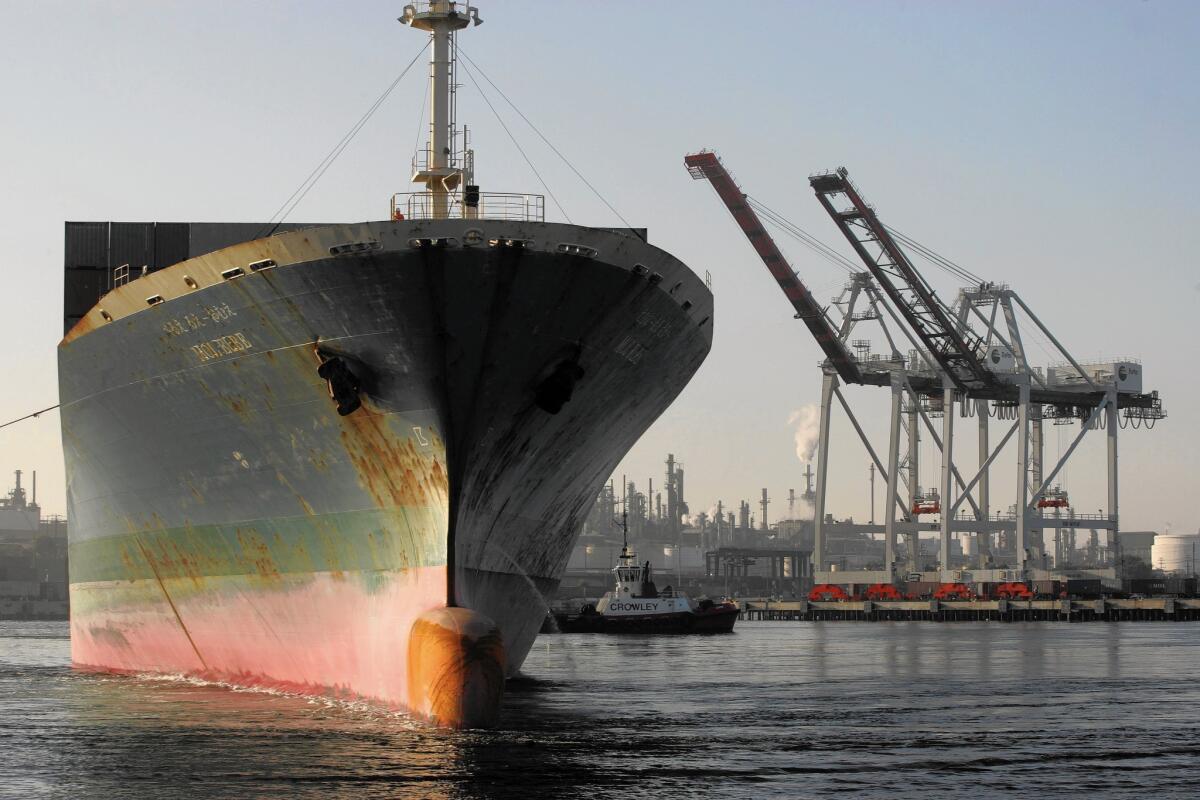Port of L.A. terminal fails to comply with pollution-reduction mandates, officials say

A cargo ship from Japan leaves the TraPac terminal at the Port of Los Angeles in 2009.
- Share via
The Port of Los Angeles has failed to meet pollution-reduction requirements at another shipping terminal, city officials said Monday, their second such admission in recent months.
The TraPac terminal near Wilmington did not comply with air quality improvement measures the city adopted years ago, including mandates that massive cargo ships shut down their engines and plug into shore-based electricity while docked to reduce harmful diesel emissions, a recent audit by the city-owned port found.
Port officials acknowledged last fall that they had failed for years to enforce similar mandates at the China Shipping North America terminal near San Pedro. Between them, TraPac and China Shipping handle about one-third of the containers moving through the port.
Despite emissions reductions in recent years, the Los Angeles-Long Beach port complex remains the largest single air pollution source in Southern California, with diesel-fueled cargo ships and trucks among the top contributors.
According to documents released last week under the California Public Records Act, ships plugged in to shore power at the TraPac terminal just 53% of the time in 2015, far below the requirement of 80%.
The port also failed to ensure that all yard equipment at the terminal ran on the cleanest possible Tier 4 diesel engines by 2014 as required by the city, the port’s review found. By that year, only 105 of 135 pieces of equipment met those emissions standards, according to the port.
Gene Seroka, the port’s executive director since 2014, blamed the shortcomings on construction work that prevented ships from using shore power and on last year’s labor-related congestion problems, which left more than two dozen ships waiting in the waters outside the port.
The backlog forced ocean carriers to charter additional vessels to deliver goods from Asia. Those vessels were not capable of plugging into shore power.
Seroka said he was heartened that the audit found the terminal was in compliance with all but three of the 52 measures required by the city, “but it still shows there is work to be done.”
Harbor commissioners approved the expansion of the TraPac terminal in 2007, imposing a series of conditions to reduce pollution and health effects on people in harbor-area communities.
TraPac did not return a phone call seeking comment. In a November letter released by the port Monday, Scott Axelson, a vice president for the company, called the failure to meet the shore power rules a “one-time shortfall” and pledged to meet them in the future.
Seroka said TraPac has also provided purchase orders to show its remaining yard equipment would be upgraded this year to the cleaner models required.
See more of our top stories on Facebook >>
Port officials launched the review of TraPac after revealing in September that the terminal operated by China Shipping had failed to comply with similar air quality improvements the city had agreed to as part of a 2004 legal settlement with homeowners and environmental groups.
The problems at China Shipping included unfulfilled promises to deploy cleaner yard tractors, cargo-handling equipment and natural-gas-fueled trucks. The public was not informed of those shortcomings.
The Times reported in December that the port had privately rolled back some of the pledged pollution-cutting measures, giving China Shipping permission to violate shore power rules starting in 2009.
Last month, state Controller Betty Yee, who is also chair of the environmentally powerful State Lands Commission, wrote to Seroka saying the port’s years-long failure to execute the air quality measures promised in the China Shipping terminal expansion “directly harms the public.”
Yee reminded Seroka that the lands commission has the power to “investigate, audit and review” the administration of the land the port sits on.
Asked whether such an investigation was imminent, Jennifer Hanson, a spokeswoman for Yee, said, “I don’t think we’re at that point; we would hope it doesn’t get to that point.”
Yee’s letter also urged Seroka to push harder to bring “zero-emissions” technology — such as clean-fuel-burning trucks and heavy equipment for moving cargo — to the port. The port’s current plans lay out “only minimal deadlines and milestones” toward that goal, Yee noted.
In a revised lease signed with the port in 2009, TraPac agreed to various environmental measures, including a gradual phase-in of the use of shore power until all ships plug in by 2018.
But TraPac was not bound by the shore power requirements until 2013 because the city took several years to install the infrastructure allowing ships to plug in, said Phillip Sanfield, a port spokesman.
Morgan Wyenn, an attorney for the Natural Resources Defense Council, said the disclosure of unmet requirements at TraPac “is significant in that it shows that the port allowed noncompliance, and didn’t tell the public about it, at more than just the China Shipping terminal.”
The problems at TraPac are worrisome because they too were kept hidden instead of being “disclosed publicly and dealt with in a public way,” Wyenn said.
In recent months, community groups and some elected officials have demanded independent oversight of the port over the unfulfilled air quality measures, which they say have harmed people’s health by allowing excess pollution for years.
[email protected] | Twitter: @tonybarboza
[email protected] | Twitter: @jackdolanLAT
ALSO
O.C. escapees held a prisoner while on the run -- and fought over whether to kill him
35 former members of California Coastal Commission oppose effort to oust executive director
Mitchell Englander and Janice Hahn lead pack in fundraising for supervisor’s races, filings show
More to Read
Sign up for Essential California
The most important California stories and recommendations in your inbox every morning.
You may occasionally receive promotional content from the Los Angeles Times.












